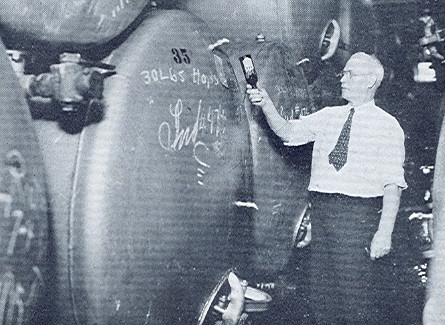Croft Cream Ale: circa 1939
This Croft Cream Ale was part of a huge find made in Vermont in 2003. Over a 1,000 ale cans were found in a large old barn while it was being renovated. I had a very rusty version of this can already, but I splurged and bought this nice indoor version as I like the three little yellow guys on the front. This can design was used before World War II and is sometimes referred to as the "lemon heads."
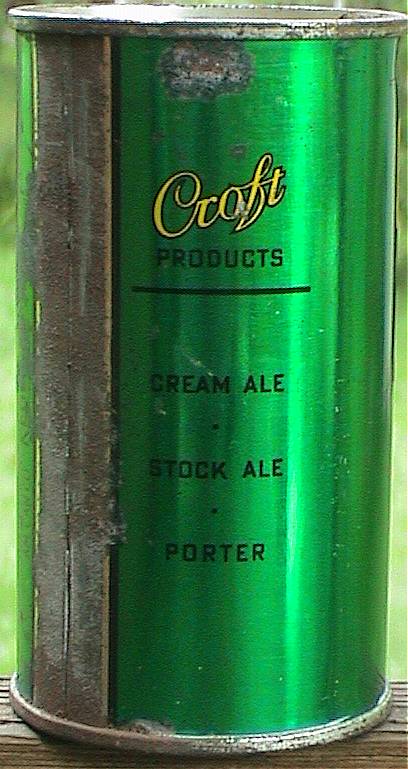 |
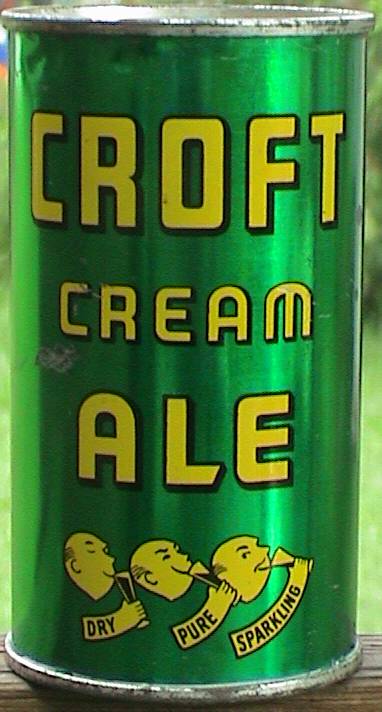 |
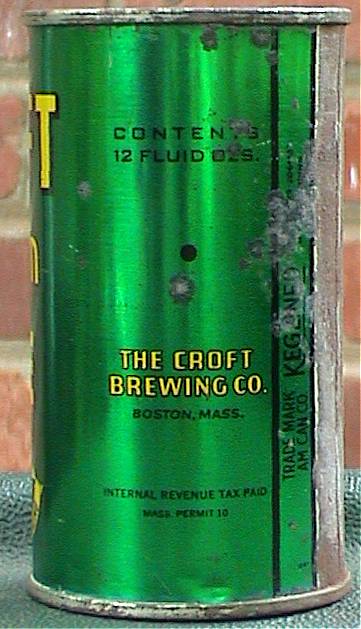
|
Croft Brewing: 1934-1952
Croft Brewing started as the Henry H. Rueter & John R. Alley Highland Spring Brewery in 1867 in Roxbury (Boston). By 1872 the facility was reported to be the largest brewery in the US and in 1876 at Philadelphia's Centennial Exposition the ale won first prize. In 1885, Alley left to form his own brewery. The new brewery was then named Rueter & Company, Inc. It was one of the first breweries to add refrigerating equipment. This raises another question, since the brewery made ale, not beer, and ale is not fermented cold, while beer is aged while chilled (i.e. lagering). Why would an ale brewery need refrigeration? Perhaps for storage rather than production? At any rate the brewery stayed in the Rueter family until Prohibition started in Massachusetts in 1918.
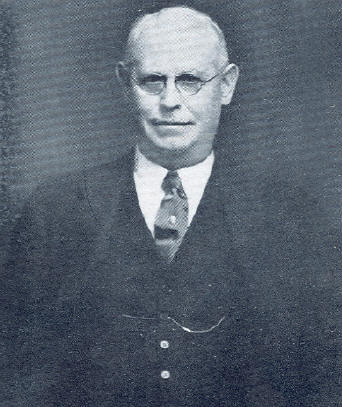 |
Walter J. Croft, about 1935.
Former Rueter & Alley / Highland Spring Brewery brew master, Walter J. Croft, re-opened the brewery in December 1933. The old brewery had been used by a metal and rubber company during prohibition. Croft had the entire building steam cleaned and sterilized and then refitted for brewing with all new equipment. Croft remained as brewmaster and R. P. Bischoff was had been President of Boston's Burkhardt Brewing, became Croft's new President.
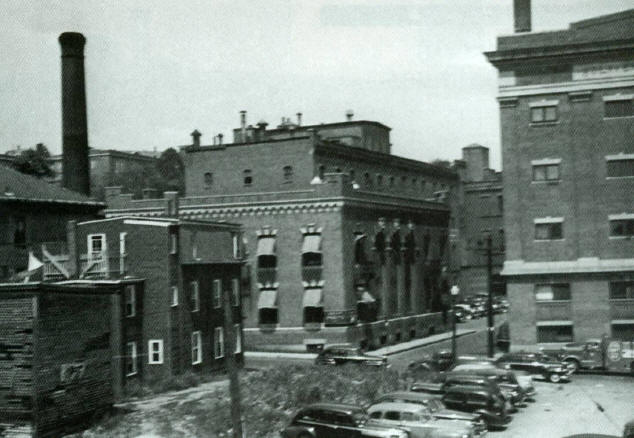
Croft Brewery, 1940s?
Croft started strong. They even had to ration their ale, selling it by quota. Distributors and other customers could only buy a set amount of cases per week until the brewery could increase production. The quota was usually sold out each week. An article in Modern Brewery magazine in March 1935 proclaimed Croft "America's Leading Ale" for having the most sales of Ale in the United States in 1933 even thought its market was concentrated in New England. New England was unique until well after World War Two for favoring ale over (lager) beer. In the rest of the US, lager beer was more popular than ale. You can see this in the brands that Croft produced, every brand popular enough to can was an ale! In July 1934 business was so good that Croft added an entirely new unit including brewing kettles, a bottling plant and aging tanks. They even tried a short-lived branch in Baltimore at the former Bismarck Brewing Company, but it was abandoned after only seven months and leased to a local group. Croft sold its Baltimore plant in 1941.
Walter Croft christening some of the new equipment in 1934.
Problems arose, however, due to faulty lining in some of the aging tanks. According to one source, Brewmaster Walter J. Croft ordered new lining for the aging tanks (no date for this order was given in the source). The new lining was supposedly superior to the existing substance which could be knocked off of the inside of the tank. Even a small amount of exposure to many metals will ruin beer so the tank lining is crucial. Unfortunately, the new lining actually slide to the bottom when the tank as filled with beer, ruining the entire brewery's production. Anyone drinking from a can or bottle of Croft from that batch must have thought that it was the worst ale ever made. They tried marketing different types of Ale, including Cream Ale, but the damage to their reputation was done.
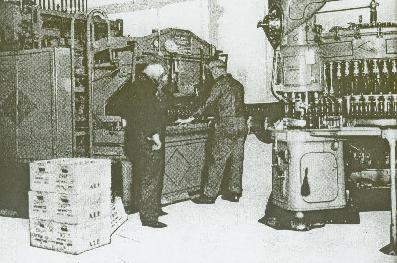
Croft's bottling machine, circa 1935.
World War Two also proved to be a blow to Croft's business, as it was to many other small brewers. The US military ordered cans as well as bottles of beer for the troops. However, much of it was provided by the larger brewers and it was beer, not ale. This proved to be a boon to the can companies as a lot of soldiers and sailors learned to like beer from cans, but they were introduced to beer from the large national and regional breweries they may never have tried before. Having developed a taste for Rheingold, or Schaefer, or Schlitz beer during the war they'd continue to buy that brand afterwards, thus costing companies such as Croft more customers.
The last couple of years that Croft was in business they produced a couple of their rarest cans, a Gamecock Ale, and Stock Ale. Gamecock only came in 12 oz cans, while Stock Ale was available in 12 oz flat tops, 12 oz cones, and in a quart cone which is very rare. Croft was bought out by one of the biggest New England regional breweries, Narragansett, in 1952. Narragansett only operated the plant for about a year until they moved production of Croft Ale to their main brewery in Rhode Island.
Croft Brewing: Early Advertising
Croft Brewing's early ads seemed to follow two themes. One was common for the period, beer as an accompaniment to food. (see ad #1). A lot of brewers used this theme during the early days after Repeal. During the pre-prohibition period, the prohibitionists centered many of their most effective attacks on the saloon and the vices, such as prostitution and gambling, associated with it. All alcoholic beverages were portrayed as attacks on the family and the home, and prohibitionist literature by groups such as the Women's Christian Temperance Union (WCTU) often centered on women's roles in banning liquor. Anti prohibition forces sometimes countered by advertising the nutritive value of beer comparing it to bread, but their efforts were ineffective.
The campaign to repeal prohibition gained ground in the late 1920s in part by borrowing the pro-family theme from the prohibitionists. By emphasizing the growth of crime during prohibition, the repeal campaign was able to claim that they were "defending the family" by removing the cause of many crimes by legalizing liquor. Making liquor legal, they argued, would move it back to the realm of reputable, and well regulated, businessmen and remove it as a source of income for criminals.
Once Prohibition ended in 1933 many breweries, including Croft, continued the efforts to tie consumption of beer to the home and therefore to the woman's realm of family. Advertising campaigns urged housewives to buy their husband's favorite brand of beer at the grocery, the implication being that the husband would not be drawn into a saloon to have a drink. Breweries published cookbooks for meals with beer as an ingredient and party guides for serving beer at gathering of friends in the home. Early canned beer was marketed as being easier for the housewife to carry home than bottles as well as being easier to store in the kitchen refrigerator. The early Croft ad pictured below shows the beer served with a wholesome meal with silverware and flowers on the table. The setting is clearly that of a home (or maybe a fine restaurant) and the flowers to one side demonstrate the presence of a woman. This is clearly not the "free lunch" with the pickled eggs and questionable food from the old time saloon. By setting the beer (or in this case ale) within a somewhat feminized scene, the brewer has made his product safe within a family setting.
These ads appeared in general interest magazines and newspapers, and even in some woman's magazines. While sports pages remained a favorite spot for beer ads, they also commonly appeared in entertainment and general news sections of newspapers, moving away from the male-only realm without abandoning it entirely. The second Croft ad (labeled below as #2) used humor to sell its product, and also tried to move the product away from the disreputable image of pre-prohibition saloons.
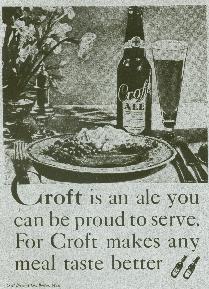 |
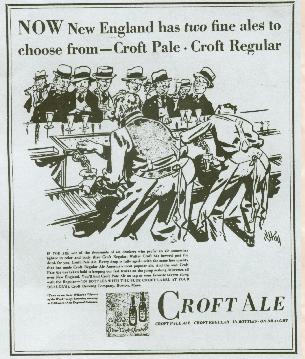 |
Croft Ad #1: Croft with food. |
Croft ad #2: A safe saloon. |
Drawn by a well known cartoonist and illustrator Stuart Hay, this ad features a scene in a saloon, but it's a much cleaned up version. The customers appear to be middle-class businessmen. All are wearing suits, hats and ties. Seven of the nine customers even have eyeglasses, which in the language of cartoons usually signified "unmanly" qualities such as meekness (or effeminateness), age, intelligence, or some combination. The bar appears to be shiny and clean, there are no disreputable women (or men) anywhere to been seen. Clearly this is not a rough sailor's bar in a bad section of town! The saloon in this ad has been somewhat subtly feminized and therefore made less threatening. No wife need fear for her family life if her husband were found in this setting.
This should not be taken to mean that Croft abandoned traditional male advertising themes, such as sports. Croft sponsored a local sports show on Boston radio featuring sports writer Neal O'Hare who called himself the "Croft Alean." The advertisements described above were intended to add a new, safer audience, not to completely replace the traditional male beer (and ale) drinker. The male customer was only to be tamed enough to steal some of the effectiveness of prohibitionist arguments.
The Lemon-Heads
In about 1939 Croft began using the logo found of the featured can. The newspaper ads I found from 1939 with this logo were surprising small, maybe an inch or two square (it's hard to tell on microfilm). This was a far cry from the full page ads using in 1934-1935. Was this a result of financial problems? Other local breweries were using much larger ads in the same paper so the small ads were not the result of legal restrictions. They also appeared in July, the peak of beer and ale drinking season, and prime time for brewers to advertise.
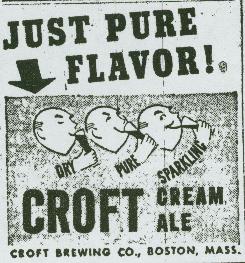 Croft newspaper ad, Boston Globe, July 1939.
Croft newspaper ad, Boston Globe, July 1939.
Why did they use this symbol? No one seems to remember, but it's been suggested that it may be a response to Ballantine 3-ring logo. Ballantine Ale was a huge seller in the region and had long used a logo with 3 interlocking rings labeled purity, strength, and flavor respectively. Was the lemon head logo Croft's response to their larger rival?
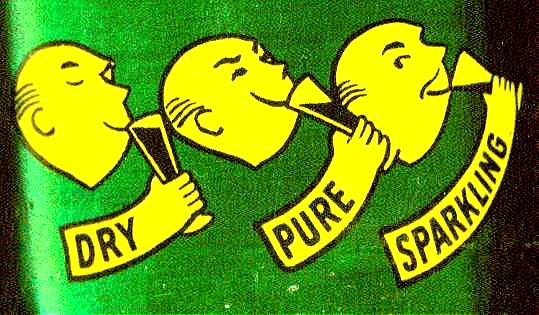 |
Close-up of the three head logo used by Croft in the late 1930s-early 1940s, sometimes called "the lemon heads."
The Pilgrim Ale Story
In 1936 Croft introduced a new brand with a lot of fanfare. To learn more, please see my November 2009 COM.
(left) A NICE Pilgrim Ale can. Thanks to John W. and Marc T. & Rustmonger for the pictures.! |
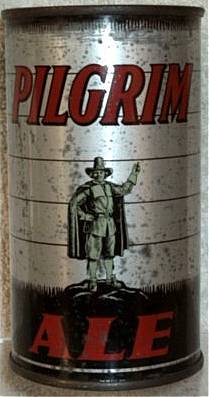
|
Croft Brewing: Name Changes and Predecessors
Rueter and Company Inc. 1885-1918
Croft Brewing Company 1934-1952
Narragansett Brewing (branch) 1952-1953
Brands of beer produced in cans by Croft Brewing.
Croft Pilgrim Ale (sometimes just labeled Pilgrim Ale)
Croft Red Label Ale
Gamecock Ale
Stock Ale
Sources Used:
Anderson, Will. Beer New England (Portland, Maine, 1988)
Beer Can Collectors of America. United States Beer Cans. (Beer Can Collectors of America: Fenton, Mo) 52.
Beer Can Collectors of America. Catalog of American Beer Cans. (1993)
Boston Globe (various dates in July 1939)
"Men Whom You Know" Modern Brewery (September 1935) np.
Modern Brewery (January 1935) 81.
Oest, Uncle Ernie "Boston: Always Famous for Beans, Once Famous for Great Breweries" American Breweriana Journal (July-August 1996) 31.
"Today Croft is America's Leading Ale" Modern Brewery (March 1935) 21-23.
Van Wieren, Dale P. American Breweries II (West Point, PA.: East Coast Breweriana Association, 1995) 141.
Thank you to Steve P., Matt M., Dave L. for the information and the photos!
Thanks to Marc R. for the correction.
Special thanks to Katie Barrett of the Boston Public Library for her assistance.

